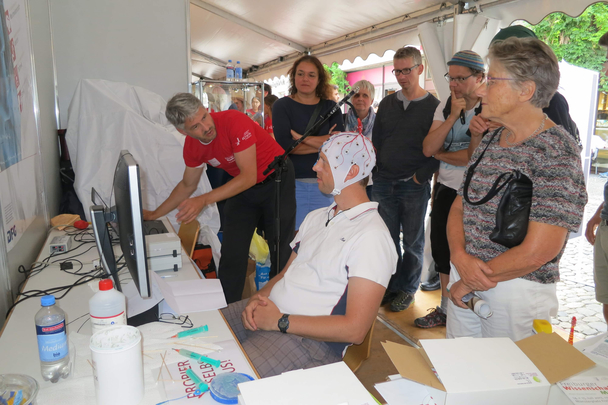
Photo: Natascha Thoma-Widmann
On July 14 and 15, 2017, the Albert Ludwigs University of Freiburg together with the FWTM invited to participate in the science fair on the Münsterplatz in Freiburg. As many as 60 stands representing academic institutes, technology companies and other research institutions demonstrated their work to the inhabitants of the Breisgau region. Whether crafting wooden figurines, writing with thought or talking with a morally thinking robot – there was something for almost every taste.
BrainLinks-BrainTools participated in this fair as well. With the support of various working groups, the Excellence Cluster was able to offer a larger stand and more program than in previous years. "In order to demonstrate neurotechnology from development to application, we have chosen a cross-section review of all three research areas of the cluster", says Mathilde Bessert-Nettelbeck from the Reaching Out project, who supervised children in the microscopy of brain slices. Microscopes belong to the most important tools for basic research in the Cluster. Her colleague, Tony Franzky, explained the visitors how the "Marble neuron" works: Researchers and craftspeople at the Faculty of Biology have built a marble run game model that illustrates the signal transmission between nerve cells. Easy-to-read introduction to Neuroanatomy rounded off this part. On Friday, the visitor's focus was a device from the clinical working group of Dr. Christoph Kaller. However, rarely used in medical diagnostics: a near-infrared spectrometer. With red light, it measures oxygen saturation of hemoglobin in the blood vessels of the cerebral cortex through the skull. The activity of the cells can be made visible on a screen presented in the swirling tints of red. "Today, I'm a test guinea pig", a female participant impishly grins, as the cap with the detectors is put on her head. Even more popular was the Brain State Decoding Lab on Saturday led by Dr. Michael Tangermann. In their demo "Writing with Thought" the Young Research Leader Group use machine learning techniques to extract meaningful information from EEG-derived brain currents and to filter out interfering signals. So by just concentrating on blinking letters on a screen, you can write words and sentences. Some of the visitors were so impressed that they wanted to participate in the demonstration several times. "It is crazy what is possible with today's technologies," says an elderly gentleman, adding that he looked into every detail of all the presented exhibits.
Next to the cluster stand, the colleagues from the BCF and IMTEK presented their demos at their best. The experiments shown by BrainLinks-BrainTools executive board member Prof. Dr. Thomas Stieglitz already belong to the classics at the science fairs in the southwest. Stieglitz is both days on site himself to actively support his colleagues. "This belongs to my work. You can never do enough for education. And eventually I'm also interested in good young scientists", he tells the organizers. "If the visitor takes a short look on the exhibits during a stroll and then wants to research himself, we will have achieved everything we wanted to reach with the participation," adds Tangermann. Fortunately, during the past weekend it has happened often enough.
Special thanks go to all supporters and, above all, to the numerous visitors!